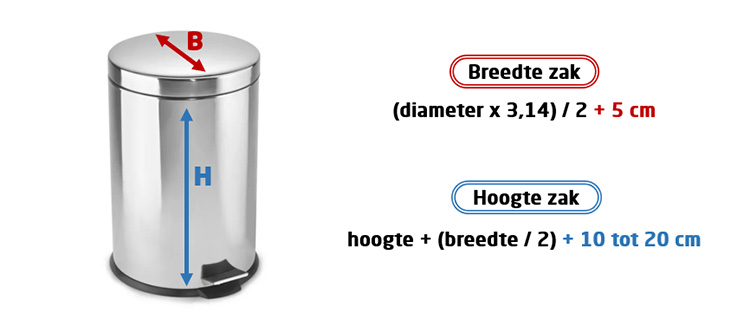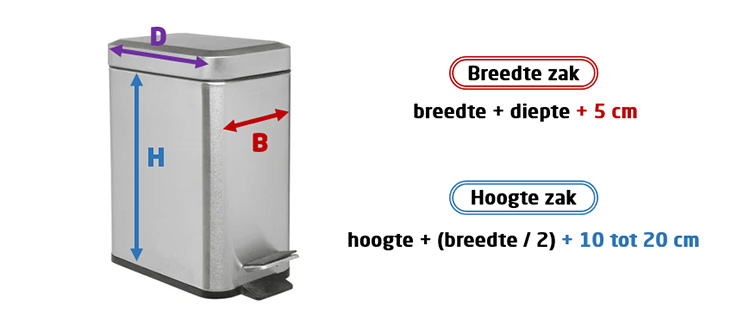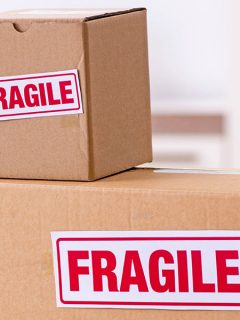Keeping your workplace orderly and tidy for you and your colleagues goes without saying. Waste management is certainly an integral part of that. In this case, we’re going to zoom in on the most important questions surrounding rubbish bags. How do you choose the right size? Does it comply with all standards and regulations? Here we give you all the information you need to choose the right bin bag for your job.
1. What size bin bag do you need?
At first glance, this question seems to have a simple answer: you just look at the filling capacity of your bin. But the answer is slightly more nuanced. In fact, the right size depends on the shape of the bin. You can easily calculate the right size using the 2 examples below.
The filling capacity of a bin is not the most important factor in choosing the right bin bag. For example, a bin bag that fits in a round bin will not immediately fit in a rectangular bin, even if they have the same filling capacity.
► 1.1 For round dustbins
For a round pedal bin, first map out the dimensions of the inner bucket. First, measure the height and diameter. For the ideal width of the bin liner, multiply the diameter (Ø) of the inner bucket by 3.14 (π) and then divide by 2. You may add about 5 cm to this to create a wider rim. You calculate the ideal height of the bag by adding the height of the pedal bin to half its width. Also add an extra 10 to 20 cm for the rim.
► 1.2 For rectangular dustbins
You calculate a rectangular bin – like a container – in a slightly different way. You calculate the ideal width of the bin bag by adding the width of the container to its depth. Be sure to add 5 cm for a wide rim. For the ideal height of the rubbish bag, add the height with the longest side (width),divided by 2. Add another 10 to 20 cm.
Choose your perfect dustbin or holder here ] ]2. What colour rubbish bag do you need?
Rubbish bag colour is mainly about selective separation and sorting of waste. Waste separation avoids mixing different types of waste so that discarded materials and products can be reused as much as possible. The path each type of waste takes is called a waste stream. If we want to reuse the waste from a particular waste stream for new products, we call it a circular waste stream.
► 2.1 Transparent
Thanks to transparency, you can immediately see what rubbish you have collected and check that it has been sorted correctly. With the same logic, use a transparent bin bag to separate your rubbish so that it can be easily sorted afterwards.
► 2.2 Coloured
In the Netherlands, as a company, you are obliged to separate waste. Fortunately, you can create a colour code to simplify the waste separation process. Thanks to coloured rubbish bags and even coloured bins or rubbish bag holders, you can assign a colour to a certain type of waste. This makes it clearer for your employees and for waste collection. Of course, depending on the sector, you can always create your own colour code. Below we give you an example of such a colour code.
| Yellow: waste paper and cardboard | |
| Blue: PMD | |
| Green (light): green waste and organic waste | |
| Green (dark): glass | |
| Red: plastic and plastics | |
| Black or transparent: residual waste |
3. Which material is best suited?
All rubbish bags are made of polyethylene, which are plastic granules made from petroleum. These pellets are melted into an elastic mush that we can classify into high-density and low-density polyethylene (HDPE and LDPE) based on density. The polyethylene varieties have distinct properties that play a certain role in the purpose of a bin bag. Before choosing a rubbish bag, it is best to keep the following information in mind. This is because the difference between HDPE and LDPE will influence your choice.
► 3.1 What is the difference between HDPE and LDPE?
High-density polyethylene is produced at low pressure, keeping the molecules intact as much as possible. This hard polyethylene has a high puncture resistance but at the same time tears faster. This is why they are more suitable for lighter rubbish such as soft plastics. HDPE refuse sacks are therefore often used in offices and sanitary areas.
Low-density polyethylene is made using a catalyst under high pressure. The molecular chains are highly branched, making the polyethylene soft. But don’t be fooled, this does make it stronger, more tear-resistant and more flexible than HDPE. LDPE rubbish bags are mainly used for heavy to very heavy waste and are often found in a warehouse, yard or other industrial workshops.
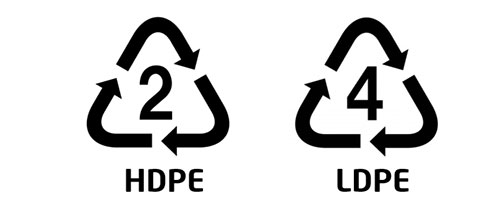
4. Which waste is suitable for your rubbish bag?
Now that you know how to calculate the correct dimensions of your rubbish bag and understand the difference between low-density and high-density, let’s move on to the practical side of things. You want to manage your waste in the best possible way and are looking for a concrete solution. First, determine the type of waste you need to dispose of. We define three categories here: light, heavy and very heavy waste. The thicker the layer of the rubbish bag, the more protection it offers against shocks, tears and sharp objects. We measure this thickness in microns and it is an indicator for which waste the rubbish bag is best suited.
► 4.1 Light waste
These rubbish bags are perfect for light and non-cutting waste such as soft plastic, used cleaning cloths and standard packaging. With the handy closing tie and sling closure, you can easily close and lift these bags. As you can see, not all rubbish bags come with a tie-tie or noose closure. Therefore, we recommend you use drill ties for the rubbish bags without closure.
Economical rubbish bag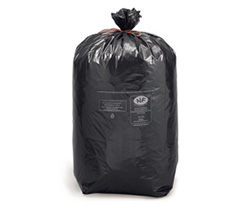 |
Rubbish bag with tie closure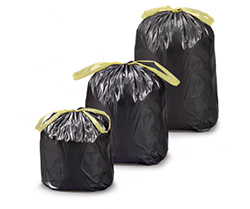 |
| – Thickness: 25 or 30 microns – Capacity: 30 to 110 L – With side gussets for more volume |
– Thickness: 23 to 34 microns – Capacity: 30, 60 or 120 L – Maximum use of bag contents – Easy to close and move |
► 4.2 Heavy waste
We consider the ‘heavy waste’ category to be everyday waste such as food waste, for example. These bags have solid protection and are shock and tear resistant. So you can move these types of bags worry-free.
Strong rubbish bag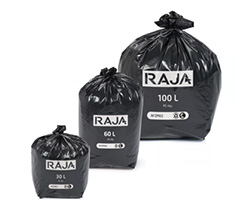 |
Blue rubbish bag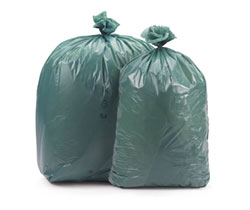 |
Yellow rubbish bag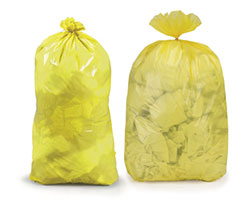 |
| – Thickness: 45 microns – Capacity: 30 or 140 L – Reinforced welds – Side gussets for more volume |
– Thickness: 45 microns – Capacity: 120 to 240 L – Very popular due to its standard dimensions and colour – Ideal for selective waste separation* |
– Thickness: 45 microns – Capacity: 30, 60 or 120 L – Side folds for more volume – Ideal for selective waste separation* |
* Thanks to its striking colour, you can easily sort plastic or paper, for example For collection.
► 4.3 Very heavy waste
These low-density polyethylene rubbish bags are suitable for sharp objects, wood, construction debris and other heavy waste. Thanks to reinforced welds, these LDPE bags offer sturdy protection against impact and tearing. That same resistance ensures that you can move or reuse the bags without worry.
Top-quality rubbish bag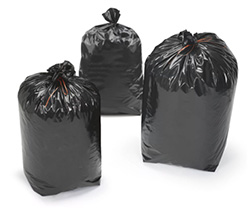 |
Rubble bag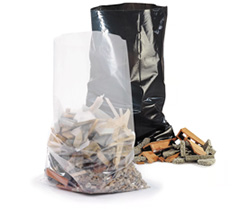 |
| – Thickness: 100 microns – Capacity: 60 to 120 L – With side gussets for more volume |
– Thickness: 140 micron – Capacity: 55 L – Black or transparent |











